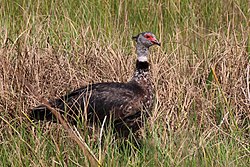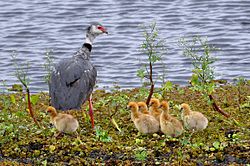| Southern screamer | |
|---|---|
 | |
| in the Pantanal, Brazil | |
| Scientific classification | |
| Kingdom: | Animalia |
| Phylum: | Chordata |
| Class: | Aves |
| Order: | Anseriformes |
| Family: | Anhimidae |
| Genus: | Chauna |
| Species: | C. torquata |
| Binomial name | |
| Chauna torquata (Oken, 1816) | |
 | |
| Distribution map | |
The southern screamer (Chauna torquata) is a species of bird in family Anhimidae of the waterfowl order Anseriformes. It is found in Argentina, Bolivia, Brazil, Paraguay, Peru, and Uruguay. [2] [3]






